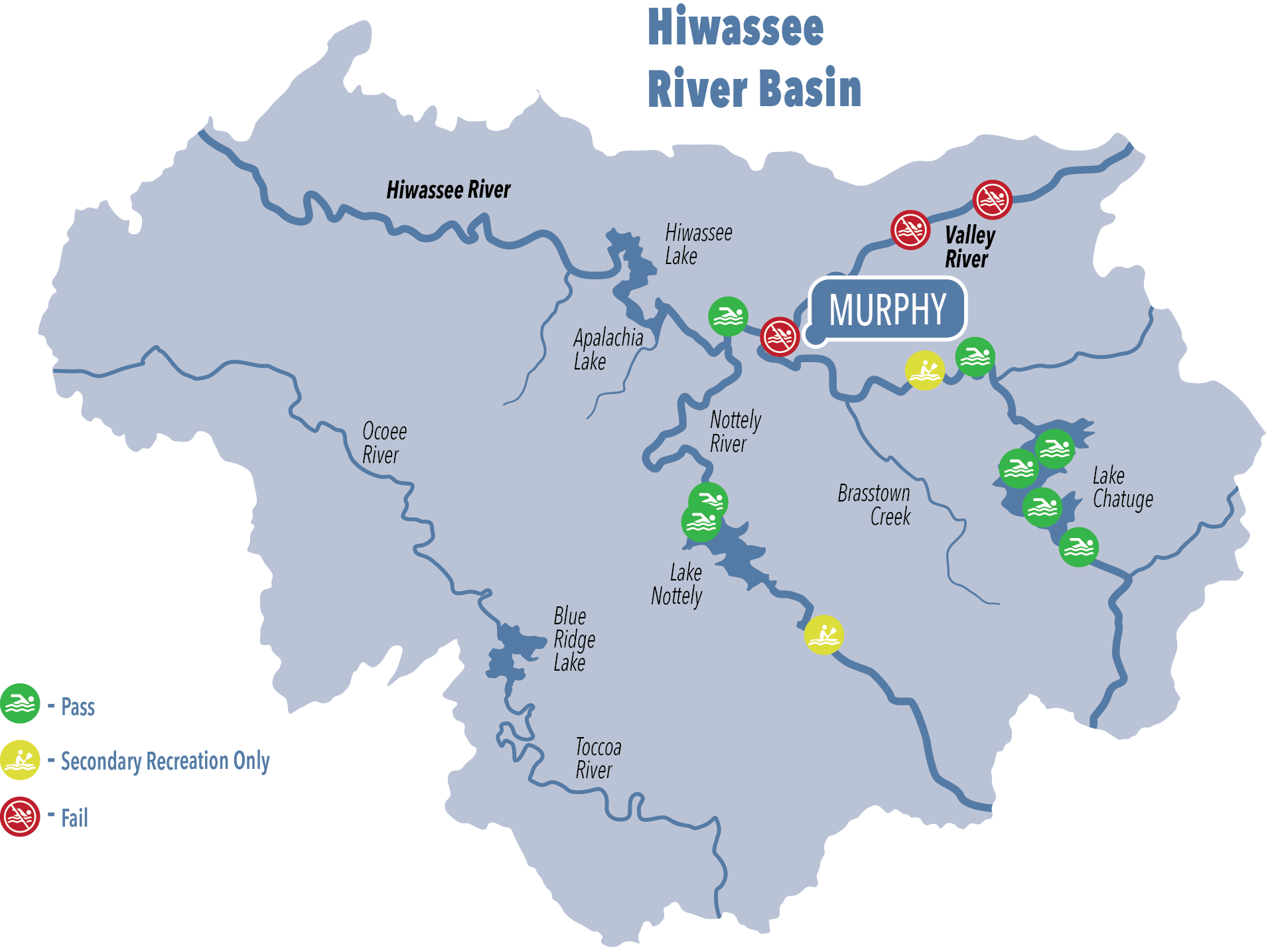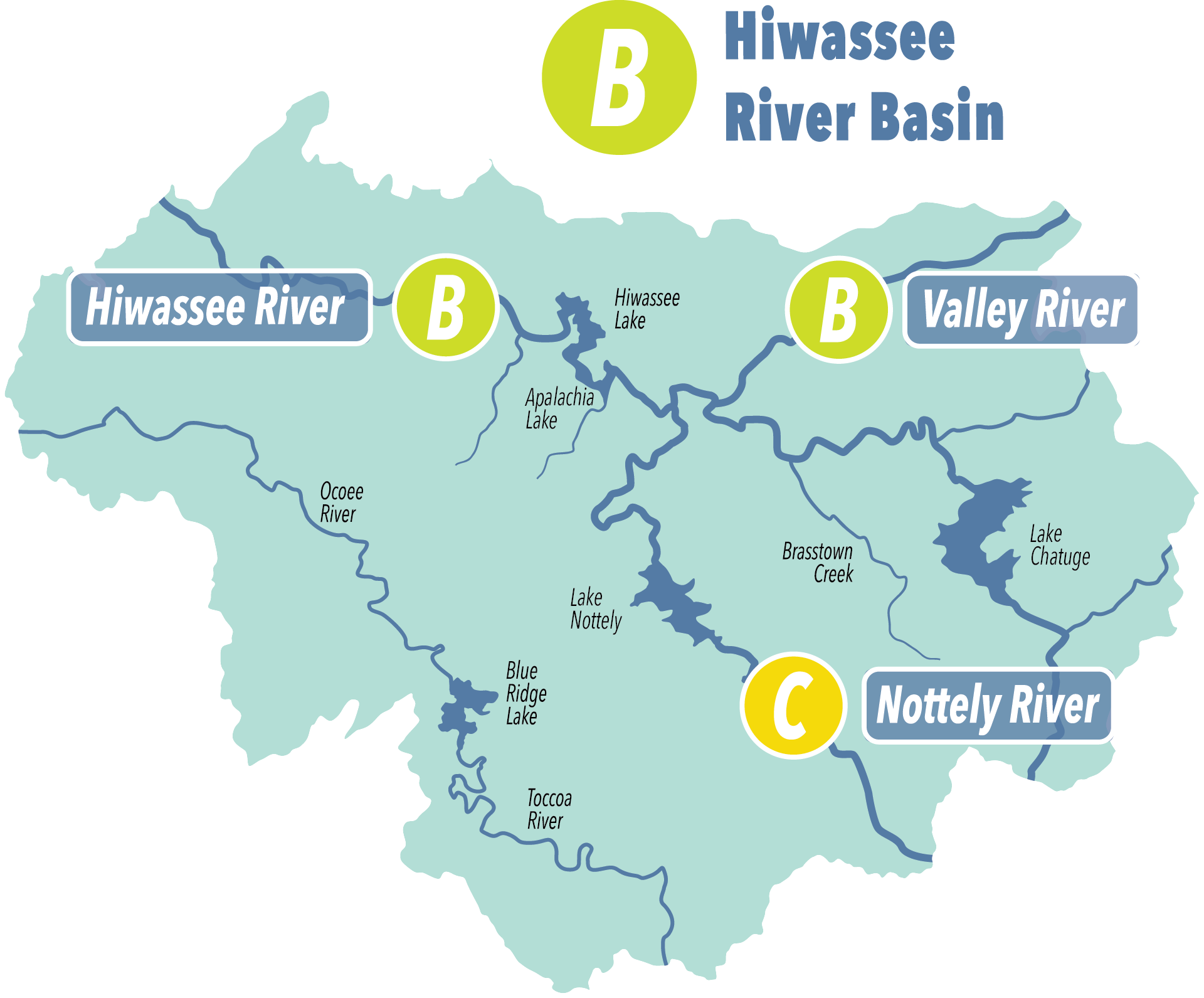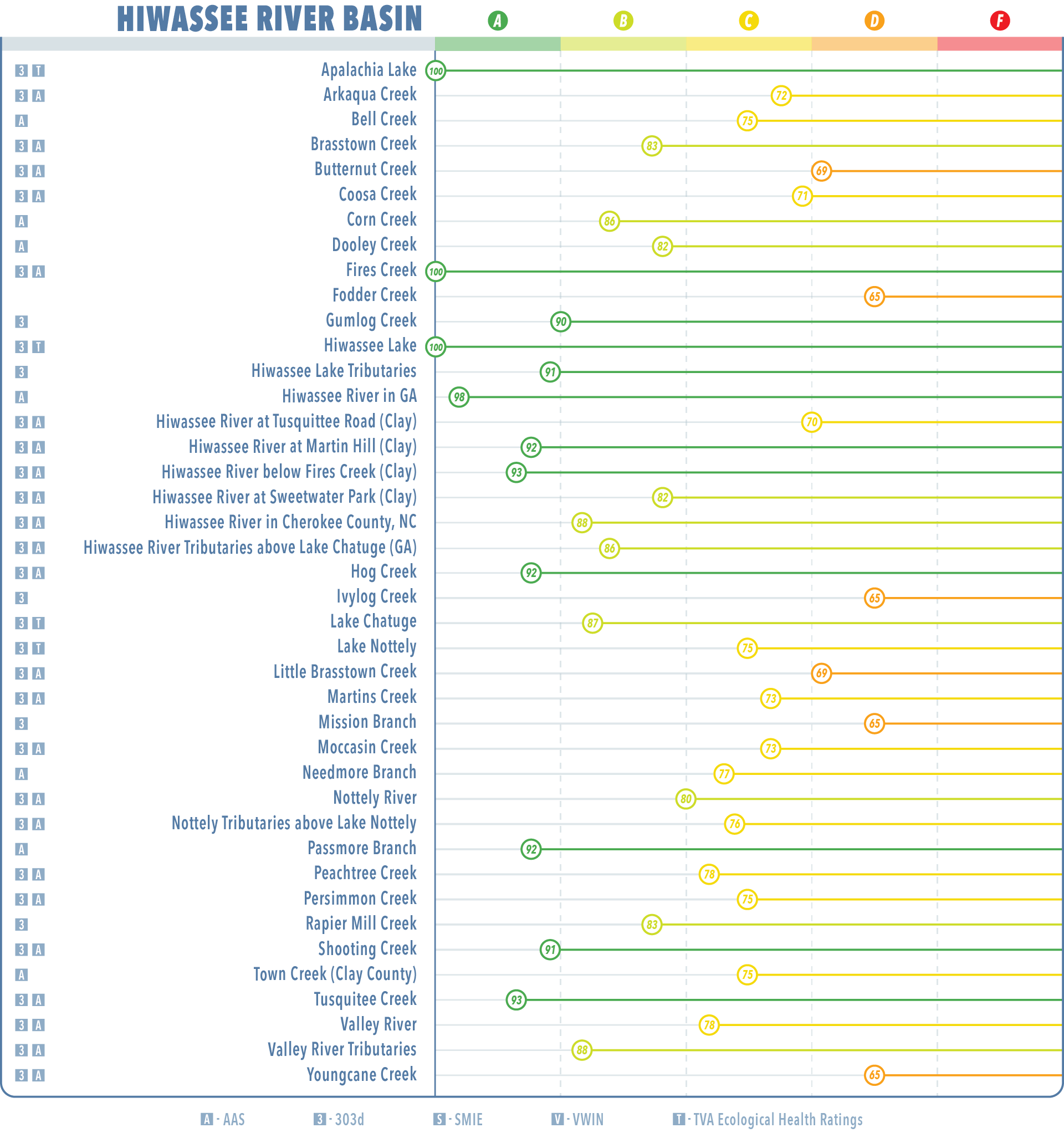State of Our Hiwassee River Basin

About the Hiwassee River Basin
The headwaters of the Hiwassee River basin originate in the mountains of northern Georgia and flow north through North Carolina before veering west into Tennessee to join the waters of the Tennessee River. Water from the Tennessee River flows to the Gulf of Mexico via the Ohio and Mississippi Rivers. The entire Hiwassee River watershed drains 2,700 square miles of land, much of which lies in the Chattahoochee (Georgia), Nantahala (North Carolina), and Cherokee (Tennessee) National Forests.
The two largest tributaries of the Hiwassee in Georgia and North Carolina are the Nottely River and Valley River. Other notable streams are Hightower Creek, Shooting Creek, Brasstown Creek, Tusquitee Creek, Fires Creek, Hanging Dog Creek, and North and South Shoal Creeks.
The Hiwassee River’s name is derived from "Ayuhwasi," a Cherokee word that signifies a savanna or meadow. This name also referred to at least two important Cherokee settlements, one in Tennessee and the other at the confluence of Peachtree Creek and the Hiwassee River near Murphy, NC. Prior to the forced removal by the United States government of approximately 60,000 people of the "Five Civilized Tribes" (which included the Cherokee) between 1830 and 1850, there were many Cherokee villages in the Hiwassee River basin. Today, small portions of Eastern Band of Cherokee Indian tribal lands are still located in the Cherokee County, NC portion of the watershed.
Two streams in the Hiwassee River basin, Fires Creek and Gipp Creek (a tributary of the Valley River), carry the highest stream classification of Outstanding Resource Waters (ORW). Additionally, Britton Creek (a tributary of the Valley River) and Tusquitee Creek are classified as High-Quality Waters, which like ORW, means extra water quality protections are in place for these special resources. Nearly all waters in the basin are classified as trout waters, which means additional treatment is required at local wastewater treatment plants. In addition, a 50-foot undisturbed trout buffer is in effect in Georgia, and, in North Carolina, a 25-foot buffer of existing trees and shrubs must be maintained between trout streams and graded construction sites to filter runoff and prevent erosion.
Flow in the Hiwassee and Nottely Rivers is regulated by the Tennessee Valley Authority (TVA) for flood control and the production of hydroelectric power via four large impoundments: Lake Chatuge on the Georgia/North Carolina state line near Hiawassee and Hayesville; Lake Nottely in Georgia near Blairsville; Hiwassee Lake near Murphy; and Apalachia Lake adjacent to the North Carolina/Tennessee border. A smaller hydroelectric dam (Mission Dam) is also on the Hiwassee River between Chatuge and Hiwassee reservoirs.
The NC Wildlife Resources Commission has identified 24 species of greatest conservation need (SGCN) in the Hiwassee River basin: 2 aquatic amphibian species, one of which is the Eastern Hellbender; 2 aquatic snail species; 5 crayfish species, two of which are endemic to the Hiwassee; 10 freshwater fish species; and 5 freshwater mussel species. The US Fish & Wildlife has identified five highly imperiled taxa: sicklefin redhorse, greenside darter, redline darter, olive darter, and smoky dace.
Fishing for largemouth bass, smallmouth bass, spotted bass, channel catfish, black crappie, walleye, bluegill, white bass, yellow perch, and striped bass has always been popular on reservoirs in the Hiwassee River basin, and Hiwassee Lake is home to the North Carolina state record for both smallmouth bass and striped bass! The lakes have always been very popular for all sorts of watersports, as well. The Hiwassee basin is also an increasingly popular fly fishing destination. And many people enjoy canoeing and kayaking too.
Nonpoint source pollution and altered hydrologic regimes are primary impacts on native aquatic communities and their habitats in the Hiwassee basin. Human population growth and associated residential and commercial development are among the most important issues in the basin. Development on steep slopes and increased impervious surfaces contribute to increased erosion and sedimentation, as well as increased wastewater and runoff of contaminants, which negatively impact water quality, hydrology, and aquatic habitat. Development is likely to continue increasing in the basin in the coming years.
Poor pasture management and cattle with wide-ranging access to streams, as well as a widespread lack of woody trees and shrubs along waterways, also contribute heavily to water quality and habitat degradation in the basin.
Swim Guide E. Coli Bacteria Analysis
The Hiwassee River was the cleanest river within our service area for the 2022 Swim Guide season with an average E. coli measurement of 71.1 MPN/100 mL across 105 samples, and the wider basin was the second cleanest with an average of 207.2 MPN/100 mL across 194 samples. The cleanest sites out of all our samples were on Hiwassee Lake, Lake Nottely, and Lake Chatuge. Much of the area is safe for primary and secondary recreational activities. However, sites on the Valley River fail regularly, and we recommend checking E. coli levels before choosing to swim or paddle this section of the river.

Valley River
E. coli and other pathogens in the Valley River come from a variety of sources that include human waste, livestock waste, and wildlife. Human waste comes from leaking and failing septic systems in older communities throughout the watershed and aging and inadequate sewer infrastructure, primarily in and around the Town of Andrews. Livestock waste originates from poor pasture management, a lack of riparian buffers, and livestock with access to streams. Waste from domesticated populations of Canada goose is also a problem, particularly at parks that border the river.
The Town of Andrews has recently received an influx of much-needed infrastructure funding from the federal government to overhaul the wastewater treatment plant, which discharges to the Valley River, as well as to repair aging sewer lines. MountainTrue currently has funding available for the repair of septic systems in Cherokee County, and we are working with elected officials in the NC general assembly to allocate more funding for livestock best management practices in WNC. See our Policy Solutions to learn more. Now, if only we could control the geese!
Total Samples Collected: 194
Average E. coli across all sites 207.2 MPN/100 mL
26.2% of sites sampled failed to meet EPA recreational standards
Nottely River: 234.8 MPN/100 mL across 45 samples
Valley River: 648 MPN/100 mL across 44 samples
Hiwassee Watershed: 71.1 MPN/100 mL across 105 samples
Cleanest Swim Guide Sites (Average E. coli):
- Lake Nottely at Poteete Creek Swim Beach - 1.7 MPN/100 mL
- Lake Chatuge at USFS Jackrabbit Swim Beach - 2.4 MPN/100 mL
- Hiwassee Lake at Hanging Dog - 3.3 MPN/100 mL
Dirtiest Swim Guide Sites (Average E. coli):
- Valley River at Konehete Park in Murphy - 753.2 MPN/100 mL
- Valley River at G. Hargett Access - 607.9 MPN/100 mL
- Valley River Park in Andrews - 580.3 MPN/100 mL
Hiwassee River at Sweetwater Park
Monthly E. coli monitoring at several locations along the Hiwassee River in Clay County, NC, upstream of Sweetwater Park, indicates that the Hiwassee River generally meets the EPA swimming standard. The problem at Sweetwater Park is that Sweetwater Creek — which enters the Hiwassee River about two hundred yards upstream — has livestock operations along both sides for most of its length. The cattle here largely have free access to the stream, and banks are heavily eroded. Only a few trees and shrubs exist along the streambanks. With little grass and no riparian buffer, rain events carry pollutants directly to the stream. The Hiwassee River is so large, and the creek flows in with such a swift current, that the flow from Sweetwater Creek hugs the bank to a point well past the park where the river access point and monitoring site are located.
Nottely River at Meeks Park II
Similarly to the Valley River, E. coli in the Nottely River comes from a variety of sources that include human waste, livestock waste, and wildlife. Human waste comes from leaking and failing septic systems in older communities throughout the watershed and RV Parks that lack adequate treatment facilities. Livestock waste originates from poor pasture management and a lack of riparian buffers and fencing. Although this site failed several times for the swimming standard in 2022, the failures are typically when water levels are lower and/or after rainfall events. When the lake is full, this site is generally safe for swimming.
Stream Health Analysis
The Hiwassee and Valley Rivers received overall grades of B, and the Nottely River watershed received a C grade. The analysis indicates better stream health overall in the Hiwassee River and its tributaries, including Fires Creek, Tusquitee Creek, and Shooting Creek, as well as Hiwassee & Apalachia Lakes.

How We Grade
A (90-100) - Excellent
Streams with excellent water quality, low pollution levels, and healthy aquatic insect and fish populations.
B (80-89) - Good
Streams with good water quality but some impacts from pollution or development. Aquatic life and fish populations were relatively healthy.
C (70-79) - Good-Fair
Streams with average water quality. There are some concerns about pollution inputs and development impacts. Generally, aquatic life and fish populations were healthy but could become negatively impacted in the future.
D (60-69) - Fair
Streams with below-average water quality. Pollution is a concern, and aquatic life and fish populations were not as healthy as they should be.
F (<60) - Poor
Streams with poor water quality. Pollution levels were often high, and aquatic life and fish populations were impacted.
Stream Health Results by Tributary
Hiwassee River Basin’s Apalachia and Hiwassee Lakes both had scores of 100, as did Fires Creek in Nantahala National Forest. Several other streams also received an A grade, including the Hiwassee River in Georgia above Lake Chatuge, Tusquitee Creek, Shooting Creek, and the tributaries to Hiwassee Lake. Streams that received the lowest health grade in the watershed (65) were Mission Branch, Youngcane Creek, Ivylog Creek, and Fodder Creek. Butternut and Little Brasstown Creeks also received a low stream health grade of 69. Overall, there are eleven A grades and six D grades, with most sites receiving a B or C. Fortunately, no single site received a failing grade.

